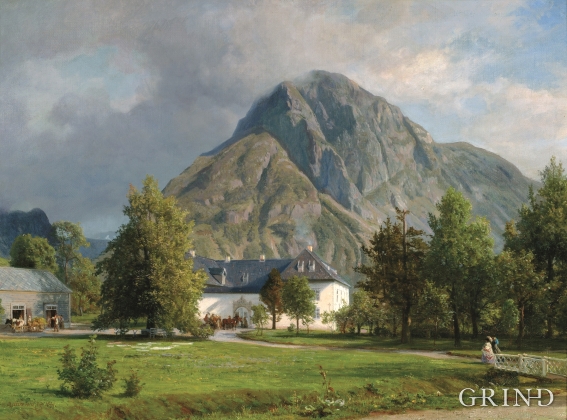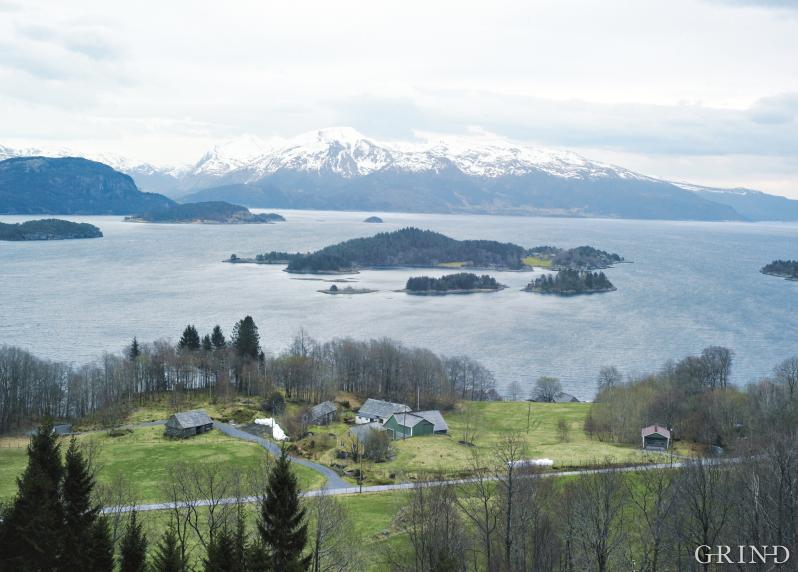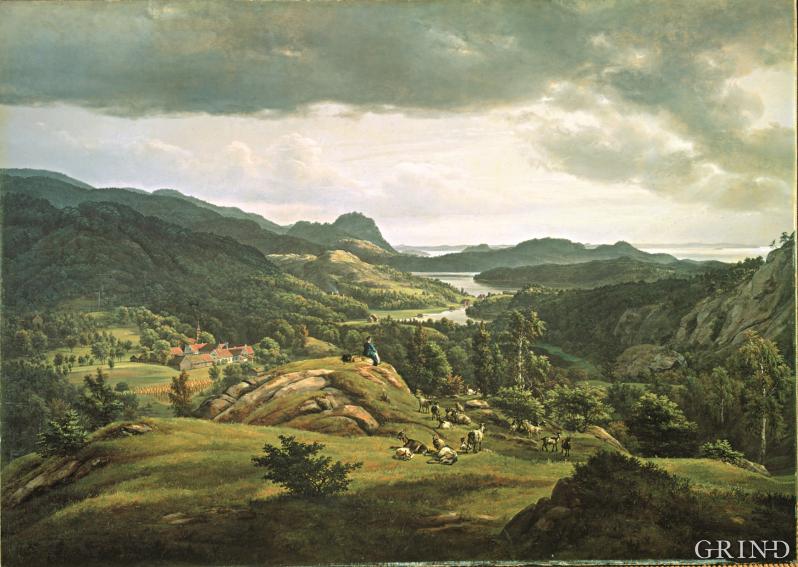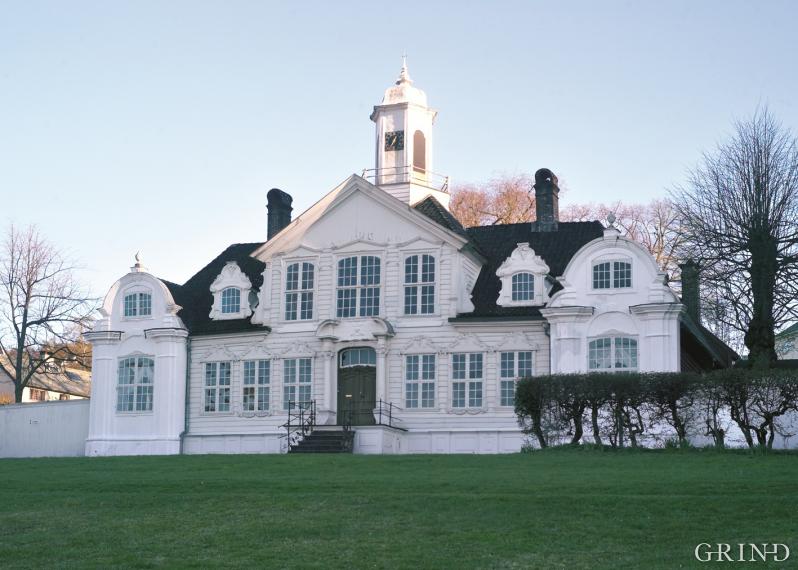Published: 19.05.2009 | Author: Ernst Berge Drange
The Rosendal Barony painted by Anders M.Askevold, 1862. (Oil on canvas. Photo: Pål Hoff, owner: Baroniet i Rosendal)
REGIONS, ESTATES AND A GOOD MARRIAGE
“The aristocracy is a gang of rough, impudent blokes. They came here to the country and make a lot of themselves and say there have never been kings or aristocracy here before. But there they are wrong. Here we have had aristocracy, both of the high and the low sort. History, noble titles, heraldic emblems and shields all tell us this. Here there have been kings, dukes, counts, barons, knights, noblefolk, weaponers, virgins, ladies and wives”.
It was Absalon Pedersøn Beyer who expressed himself in this way in 1567. And he is both angry and offended. However they had much right on their side, these impudent intruder that Mr. Absalon must have met in cultivated circles in Bergen. By European standards there was no nobility in Norway.
One reason was that the word was not used before the 16th century even if there was a social group who could described themselves with the term “noble”. Because in Norway there were also people and generations who from time immemorial enjoyed privileges in the form of tax immunity and who had the special protection of the king.
Another was that such aristocratic special rights were not well developed in this country. The Norwegian nobility had never had any personal military power structure as was the case on the Continent, with forts and armoured knights. Neither did they have any legal powers of judgement. And the estate properties which should have served as basic economic foundations were small and spread out. They were so-called random properties. Usually it was a matter of part ownership which is to say that the landowner did not have direct ownership rights, only tenancy payment rights. He owned part of the charge, the tenancy payment a farmer had to pay the landowner for the use of the land.
The tenancy payment was originally a certain share of the harvest from the farm. Thereafter it became a measure of the value of a property. In our area the tenancy payment was usually made in butter and in animal hides, but out at the sea it was also paid in fish.
The number of Norwegian noble families was small in Mr.Absalon’s time. There was only 50 of them as opposed to 300 around 1300. The Black Death and the crises in the late Middle Ages had hit this social group particularly hard, both in terms of numbers and of estates. But the nobility did have a tendency to “die out” whether there was a crisis or not. However the opposite could also happen, but with the same consequences. There were too many heirs and the estate was split up. The noble families sank down into the farming classes. This is the reason that many Hordaland folk can trace their relatives back into the old nobility.
The new time
Absalon Pedersøn Beyer who wrote the work, “On Norway’s Kingdom” in 1567 and who used such scathing words of the nobility, lived at the critical juncture between an old and a new time. After the population of Norway had stood still for several hundred years, it had increased considerably in his lifetime. This development took off after the 17th century. There were blossoming periods of progress with rising production of agricultural goods. Industries like forestry and fisheries made particular progress. Trade also experienced an upswing both with inland and with overseas.
The Lutheran faith was introduced to the twin kingdom in 1536. This also influenced the church as a property owner. In the Middle Ages the church had been the biggest property owner in Norway, with almost 40% of all properties. In comparison the aristocracy had only 20% at the most, and this was greatly reduced during the late Middle Ages.
The church estates in the Middle Ages were divided up between different institutions such as the bishop, the chapter, the monastery, the church and the priest. With the Reformation everything came under the Crown. So it became the property of the King. But the local church estates continued to be a part of the incomes of the priest and he church. Until the great crown land sale in the middle of the 17th century over half of all landed properties in Norway were under the Crown.
This is the reason for the great immigration of foreign nobility to Norway during the 16th and 17th centuries. The king had great properties to be managed, royal fiefs with good incomes for the royal representative who was usually a foreign nobleman. There could be a great administrative district like Bergenshus county with a palace, or they were larger royal estates like Halsnøy Monastery. But the fief could also be a single farm property which the Crown owned from before. Otherwise the period of rampant speculation around 1600, especially in sawmilling operations, good opportunities for those who were fortunate.
Many of the new young men in the Norwegian aristocracy were adventurers who could well have a good reputation, but who had little economic power. They were on the look out for noble estates, properties, farms and a good marriage. Most of them came from Sweden and Denmark, but also from Germany. But many of them is was only a question of a brief stay.
Sunnhordland - A core area for the nobility in western Norway
A core area for what we could call the old west Norwegian nobility was inner Sunnhordland. Here there were several families with long traditions: Galtung, Rustung, Slee, Dall, Haard and Orm. The noble families in Nordhordland and in Bergen in the 16th and 17th centuries were, on the other hand, mainly immigrants. They were the Bildt family from Båhuslen and the Lunge, Juel and Rosenkrantz families, all of Danish origin.
There were few places where noble estates were more densely situated than in Sunnhordland, and especially around the mouth of the Hardanger Fjord. In Kvinnherad and in Tysnes. The noble estate was the name of the estate of a noble family, an estate which had certain privileges, for example, immunity from taxes. 39 such estates are recorded in Hordaland in the 16th and 17th centuries. The great estates which the king owned from olden times are not included. These were estates which the king gave free of taxes to those who had done him a service.
Of the 39 estates, 23 were situated in Sunnhordland. And as far as the estates in the northern part of the county were concerned, most of these were owned by Aksel Mowat who lived at Hovland in Tysnes. Ask on Askøy also came into the hands of the Mowats.
What then was the reason for the many estates in Sunnhordland? We usually think of noblemen as estate owners of big farms with large production, many works and method of operations which were above the ordinary. But it was not like that here. The Hordaland nobility were estate owners only in the sense that they owned many farms. But these were used by farmers against fixed annual rents, the land rent. Some of the properties distinguished themselves with their high rents, their large numbers of cattle and good corn harvests. But not all of them. Etne was the only area in Sunnhordland which could sell corn in a good year. But in this parish there was only one farm which can have had noble residents and that is the old royal farm Stødle, Erling Skakke’s farm.
If we look at the noble estates on Tysnes, where they were most densely concentrated, they were mainly good forest estates. The nobility in Sunnhordland in the 16th and 17th centuries were also for the most part forest owners and timber merchants. Olav Kolltveit wrote of Laurits Johannesson Galtung of Torsnes (1587-1659) that he operate the biggest sawmill in Hardanger and Sunnhordland at Torsnes, and he did not save any other forests than the forests at Torsnes. Bernt Orning of Vatna (born about 1614) operated sawmills at Orninggård and at Sagvågen on Stord.
In Sunnhordland there were broad plateaux with good, easily worked forest, especially in Kvinnherad and on Tysnes. In Nordhordland the forest was sparser and the forest that grew further inland, as in the rural districts around Voss, was more difficult to ship out. But the nobility were also employed in trade in herring and in fish. This is shown by a royal missive from the beginning of the 1580s. In those times the sources tell of the first known spring herring period in western Norway. And new markets were opening up for herring. The estates in Hordaland were marine estates, and the resources from fisheries and from the use of the sea were particularly good. Besides the incomes from the land rents, forestry, timber trade, saw milling and the herring trade formed the economic basis for the nobility in Sunnhordland in the 16th and 17th centuries.
The nobility of Sunnhordland in crisis
But after a blossoming period of progress came a crisis in the 1620s. The noble businesses were subject to economic cycles. Nonetheless over-exploitation of the resource base is thought to have been the most important cause of the economic crisis which befell both the nobility and others. The forests were more and more logged out. The period of rampant speculation was at an end.
But the recession also had its origins in increasing pressures from taxation. The burden of taxation on Norwegian farmers was multiplied many times from 1626 and onwards into the 1660s, as a result of the many wars that Denmark-Norway was involved in during these decades. This made the farmers more vulnerable, and the incomes for the nobility more uncertain. The nobility was hard hit by the so-called equipment tax which was first levied in 1625. This was a monetary tax instead of the duty a land-owner had to equip a knight for war service. And the saw mill owners also experienced an increasingly heavy tax burden which led to the water-powered sawmills being given up in increasing numbers.
The old noble families of Sunnhordland received a deathblow at this time. Large properties were mortgaged and the work the Norwegian nobility did to get more noble estates approved showed little progress. They were allowed to keep the noble estates free of taxes, and for a brief period, there was immunity from tax for adjacent work farm (vekedagsgods). The work farms were the nearest neighbouring farms to a noble estate, where the farmers had a duty to work to a certain degree. In Sunnhordland this system was not much developed.
The indebted noblemen of Sunnhordland did not manage to redeem the farm which had followed the family from far back in time. The work in obtaining immunity from tax for the noble estates and the vekedagsgods was met by counter-action by the king. In an open letter in 1639 it was stated that no estate could be regarded as a noble estate unless the noblemen boarded and lodged there. In addition the estates should have been held for 40 years with all privileges. Nor should they ever have been in the hands of “unfree” folk - that is folk who were not noble, either mortgaged or in ownership. In 1646 the sheriffs were instructed that they must be diligent to ensure that no estate could pass itself off as a tax-exempt estate. Here no one would be able to dodge his tax duties.
Axel Mowat - and Rosendal barony
In this situation it was little consolation that it was one of their own people, Axel Mowat from Tysnes, who got his hands on most of the estates. Axel Mowat was the son of a Scottish nobleman, Anders (Andrew) Mowat who emigrated to the kingdom at the end of the 1580s. He married the noblewoman Else Tronds of Gjersvik in Tysnes, daughter of Kristoffer Rustung and widow of Jon Haard. Anders Mowat had lived as the manager for a large noble estate on Shetland, but he had also obtained lands himself. It was through his marriage with Else Tronds that he obtained more properties. These were estates that had been in the hands of the noble families, Kruckow, Haard and Rustung. Else and Anders Mowat bought two estates on Tysnes in the beginning of the 1600s, Hovland and Sande. And here in 1606 they established the noble estate of Hovland.
But it was their son Axel Mowat of Hovland who was the great collector of estates, first through his marriage with Karen Bildt, and then as the banker for the standsbrørne in Hordaland (e.g. Dall and Orning). Over two generations the Mowat family got their hands on most of the old noble estates in Sunnhordland, but also some in Nordhordland. With these came many of the ancient noble estates: Hatteberg, Mel, Seim and Enes (Kvinnherad), Hovland, Onarheim, Gjersvik, Håland and Malkenes (Tysnes), Akselvold or Fonnes, (Austrheim) and Hodne (Lindås), Ask (Askøy) and others. The estates belonging to Aksel Mowat were valued at over 350 churns of butter or about one seventeenth of all property in Hordaland. In Tysnes he owned one third of all the land rent in the parish.
Axel Mowat’s estate was the basis for the great landed property which later came to fall within the Rosendal Barony. But after the collector came the destroyer.The Dane Ludvig Rosenkrantz was married to the sole heiress of Axel Mowat and Karen Bildt, their daughter Karen. Together with her he took over one of the biggest landed estates in the twin kingdom. He managed to ruin much of this. But he did build up the Barony Rosendal, with a castle in stone, before the family died out. The construction of the castle was certainly the most important cause of the poor economy.
Ludvig Rosenkrantz’s strategy had otherwise been to maintain immunity from tax for as many of the old noble estates he had inherited with Karen Mowat. Because despite the regulations that the nobility had to live on their noble estates, there were enough of these for it to be only a formality. But it did not take long before Ludvig Rosenkrantz was charged with cheating on taxes. The prosecutor, the royal public servant, who was responsible for the charge expressed himself so that he was of the opinion that much of the estates of Ludvig Rosenkrantz did not possess the legal privileges which they should have had. The conclusion was that most of the farms (from 1666-67) were regarded as ordinary farms and subject to tax.
The next move by Ludvig Rosenkrantz was then to establish a barony; a collection of noble estates with its own civil administration and its own court (a noble’s court). This was in line with the wishes of the absolute king to develop a new county nobility to weaken the traditional hereditary nobility. The Royal confirmation for the Barony of Rosendal was drafted in 1678. But it was Norwegian law which governed. Thus the tenants of the Barony were as secure there as elsewhere, that is to say they had security of tenure for life.
Halsnøy and Lyse monastic estates
Besides Rosendal Barony there were two other collections of estates which in Horaland at the end of the 17th century had their own administration and courts. These were Lyse and Halsnøy monastic estates which had been allocated to the king during the Reformation, and which he in his turn had “lent”, often to foreign noblemen. Halsnøy monastery lost its local court in 1673 when the estate was put under the district magistrate for Sunnhordland. The Lyse monastic estate was legally administered by the district magistrate in Hardanger and Voss.
Lyse monastic estate (most of it in Os) was valued at 318 churns of butter, or about one nineteenth of the total land rent of Hordaland. Halsnøy monastery was one of the biggest monastic estates in Norway, being valued at around 730 churns of butter. But a part of it lay in the existing Rogaland county .
The magistrate Nils Hansson Smit got the title document to Lyse monastic estate in its entirety. Halsnøy monastic estate was sold off, farm by farm in the 1750s with the tenants being given the right of first refusal. But the two monastic estates were still for some time separate civil administrative units; Lyse monastery until late in the 19th century. The Formann family as landowners sold to the tenants in the second half of the 19th century. Only in the 1930s did the Rosendal farmers become owners of their own properties.
If the old noble estates did not distinguish themselves particularly from the ordinary farms, the main farms on the Rosendal barony, the Lyse and Halsnøy monasteries were reckoned as major landed properties. They were also something special in the minds of ordinary folk. Rosendal had a castle; the monastery estates had “ancient walls and buildings which were, however, now rather derelict and ruinous” which is how Halsnøy was described in 1714. Here there stood for a long time an old stone hall which was part of the main building and a memento from the monastery times. Right up unto our times these farms served as models on the introduction of new methods in farming and forestry.
Noble life and ways of living
Ludvig Rosenkrantz was the only noblemen in Hordaland who could be described as being of the European format. The castle he had built at Hatteberg was the most important symbol of this. He was also the “lensherre” (the king’s representative). He was positioned directly below the king and had no ties with the civil administration.
The old nobility in Sunnhordland can be said to have been “provincial”. They lived in timber houses, even if these were larger than farmer’s dwellings. But they did not live a life in luxury, supported by servants. In 1645 Børge Juel of Lungegård and his wife Blanseflor Bildt has only one personal servant each, he a boy, and she a girl. They had a cook and a girl herding the animals. Three lads and three cottars - “with their womenfolk” - ran the main farm. At the other farm Årstad there was a tenant with two working lads.
Children of the nobility received an education above the normal. But the education was not better than the king - in a letter to the royal representative in Bergenshus - asked him to make sure that children of the nobility should be sent to the royal academy at Sorø, if they had parents who could afford to pay for their stay there.
The noble families meet their fate
Axel Mowat got hold of most of the old noble estates in Sunnhordland. There was, however, one of the families which managed its way through the crisis in the 1630s and the 1640s and that was the Galting family of Torsnes in Hardanger. Laurits Galtung had to flee the country after he had killed his kinsman, Axel Mowat the younger in a pistol duel in 1643. Later he was pardoned and in 1648 his patent of nobility was renewed.
But the Galtung family also met their fate. It was a trivial as Johan L.Galtung (1658-1721) “out of weakness, and when he found no other way out, married Margrete Leganger, the daughter of a priest who became my mother”. It was his son Lars who wrote these cunning words. Through marriage with a woman commoner the noble title was lost.
The last baron of Rosendal, Axel Rosenkrantz also had to make do with the daughter of a priest. The noble families shrunk more and more. The overseas contacts had become fewer and there was not an equal match to be found. And so, little by little, the whole of the old noble families had vanished from the historical scene.
- Bakkevig, E. (1941-1943) Sunnhordland-slekter.
- Holmsen, A. (1980) Gård og gods i Norge i eldre tid. Oslo, Universitetsforlaget.
- Reksten, E. (1985) Krongods og kongsmenn: jordsalg og sosial endring på Vestlandet 1650-1700. Oslo, Novus.
- Den Nordiske adel i senmiddelalderen: struktur, funktioner og internordiske relationer: rapporter til det Nordiske historikermøde i København 1971, 9.-12. august (1971). København.











